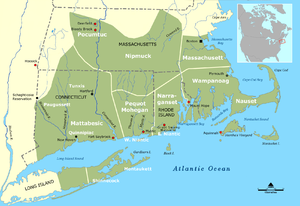Pequot language
| Mohegan-Pequot | |
|---|---|
| Native to | United States |
| Region | southern New England |
| Ethnicity | Mohegan, Montauk, Niantic, Pequot, and Shinnecock |
| Extinct | 1908, with the death of Fidelia Fielding |
|
Algic
|
|
| Language codes | |
| ISO 639-3 | |
| Glottolog | pequ1242 |

The location of the Mohegan, Pequot, Montaukett, Niantic, and Shinnecock, and their neighbors, c. 1600
|
|
Mohegan-Pequot (also known as Mohegan-Pequot-Montauk, Secatogue, Stockbridge, and Shinnecock-Poosepatuck; dialects in New England included Mohegan, Pequot, and Niantic; and on Long Island, Montauk and Shinnecock) is an extinct Algonquian language formerly spoken by indigenous peoples in southern present-day New England and eastern Long Island.
The Mohegan Indian Tribe was historically based in central southern Connecticut. While originally part of the Pequot people, it gradually became independent and allied with English colonists in the Pequot War of 1637. This broke the power in the region of the Pequot who were formerly the dominant tribe. In reward, the English gave Western Pequot taken as captives to the Mohegan.
In 1933 John E. Hamilton, also known as Chief Rolling Cloud, was appointed Grand Sachem for Life of the Mohegan by his mother, Alice Storey. The Mohegan had a matrilineal kinship system, and male leaders were chosen by women elders from families with hereditary claims to the position. Storey was a direct descendant of Uncas, the great 17th-century leader of the Mohegan Nation, and of Tamaquashad, Grand Sachem of the Pequot Nation. In Mohegan tradition, the position of tribal leadership called Grand Sachem had always been hereditary through the maternal line.
Gladys Tantaquidgeon, who died at the age of 106 in 2005, served for years as the Tribe's medicine woman and unofficial historian. She became an anthropologist and worked for a decade with the federal Bureau of Indian Affairs. Returning to Connecticut, she operated her family's tribal Tantaquidgeon Museum for more than 50 years, beginning in 1947. It was one of the first museums to be owned and operated by Native Americans.
John Hamilton was a key figure among Native American leaders initiating late twentieth century land claims suits. Tribes in the Northeast had long interaction with European Americans. There was continued encroachment of their lands, even when colonial-era reservations were established. By the early 20th century, many of the tribes in the Northeast were essentially landless.
...
Wikipedia
